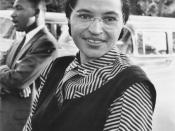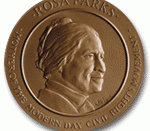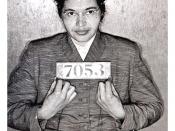Born on February 4 1913, Rosa Parks was the daughter of James McCauley and Leona Edwards. McCauley, a carpenter, and Edwards, a schoolteacher, named Rosa after her maternal grandmother. McCauley was mostly a builder. Rosa was a sickly child and small for her age. It was hard for her mother to take care of her because her father was absent much of the time. They lived as a family in Pine Level, Alabama until Rosa was two and a half years old and she did not even see him again until she was 5 years old and her brother was three years old. He came back but he left and she did not even see him until she was a married adult. She was a fatherless child most of her life. It changed her life completely to grow up with no kind of father around to guide her. Rosa had brother named Sylvester and as they grew up with each other she became very protective over her brother.
She let anybody brother or mess with him. She never did get out of that attitude of trying to be protective of him. " One day when I was about ten, I met a little white boy named Franklin on the road. He was about my size, maybe a little bit larger. He said something to me, and he threatened to hit me-balled his fist up as if to go give me a sock. I picked up a brick and dared him to hit me. He thought better of the idea and went away."� At that early age, she did not suppose to retaliate on white people even if they did something to you. She knew at the age of ten that she had much in her rights to defend herself just like the whites.
Rosa was too aggressive for her age of time. Rosa start to attend school and she was a very bright girl but she realized that the white schools was in better conditions than the black schools. "�Rosa first school was a small shack, and the students had few textbooks."� She learned that the white schools were federal funded and the blacks was build and heated without the help of the town or state or country. Rosa slowly began to believe that black people are not free. When she moved to Montgomery, Alabama, she realized how segregated blacks and whites are. Blacks and whites could not stay in the same hotels, use the different bathroom, have different water fountains, eat different restaurants, and sit different in bus transportation. She could not believe how separate as a people we were. She meets her husband Raymond Parks and married him in December of 1932 in Pine Level in Rosa mother's home. She received her high school diploma in 1933 when she was twenty years old. Raymond Parks was the very first activist she ever came across. Raymond Parks was a long-time member of NAACP, the National Association for the Advancement of Colored People. Parks got involved in voter registration because he was not satisfied with the few blacks that were voting. So Rosa first year to try to vote was 1943 and was denied another two times but finally on her fourth try she passed and got her certificate in the mail.
Rosa was a registered voter but the second time when she tried to register to vote. She was put of the Montgomery city bus for the first time. The reason was because he did not follow the rules on the bus. The rules were black sit in the back of the bus and the seat in the front was reserved for whites. She was forced off the bus by the driver and people was thinking why did not she just do follow the rules because during those times blacks did not fight back at all. By the time she was put off the bus, She became a member of NAACP, National Association of the Advancement of Colored People. NACCP was started on February 12, 1909 in the honor of President Abraham Lincoln's birthday.
The group was formed to protest against racial discrimination, lynching, brutality, and inequality. Rosa believes strongly in black equality. Rosa became the secretary and she was the second woman to be involved in the NAACP meetings. "Most of the members of the Montgomery NAACP were black. White people had to have a lot of courage to join, because they would be ostracized by the white community."� Rosa understood that not all white people wanted black inequality and there were some "good"� white people who wanted to see black people get the respect they deserved. On December 1,1955 she boarded Cleveland Avenue bus to go home and she forgot to check the driver before she got on. When she paid her fare she realized that it was the same driver who put her off twelve years ago.
"The "ÃÂreserved seats' were partially filled, but the seats just behind the reserved section were vacant, and Mrs. Parks sat down in one. It was during the busy evening rush hour. More black and white passengers boarded the bus, and soon all the reserved seats were occupied. The driver demanded that Mrs. Parks get up and surrender her seat to a white man. Besides, she was a woman, and the person waiting was a man. She remained seated."� "The driver of the bus saw me still sitting there, and he asked was I going to stand up. I said, "ÃÂNo.' He said, "ÃÂWell, I'm going to have you arrested.' Then I said,' You may do that.' He got out of the bus and stayed outside for a few minutes, waiting for the police."� It is believed that Rosa was tired and that was her reason for not giving up her seat. According to Mrs. Parks, that was not the absolute truth. She was neither old nor physically tired. In fact, she was only forty-two at the time and she was merely mentally tired of the whole racial discrimination issue. She was completely tired of giving up. Rosa knew that it was time to stand up in what she believed in. She waited until the two policemen came. One of the policemen had the nerve to ask her why she did not stand up. She asked him, "�Why do you all push us around? And I quote him exactly, "ÃÂI do not know, but the is the law and you're under arrest."� So Parks was taken to jail on North Ripley Street, booked, fingerprinted, photographed, and locked in a jail cell. Through this whole process, she remained quiet through this whole process. She refused to speak make any comments.
She was not frightened and was able to keep her anger inside. She made her one phone call and her husband agreed to come up to pick her up. There was already around about her arrest. Everyone was angry about what happened to Rosa and talking about it should never happen again. Many black leaders were outraged by Rosa's arrest. A group of ministers, Jo Ann Robinson and others of the Women's Political Council wrote a letter. It was telling people not to ride any buses so that the protest will be successful. The boycott went into a effect on December 5, 1955. The next day Rosa's trial started. It was not a long trial at all. It lasted only thirty minutes. Charles Langford and Fred gray defended Rosa in her trial. "The drama leading up to the trial and the trial itself was a lifetime in the making."� This case was important because it triggered the Montgomery bus protest. Rosa was found guilty and she appealed the ruling. Rosa was released on bail. Three-judge federal District Court ruled two to one in favor of our suit against segregation on the buses but the city commissioners appealed the case to the Supreme Court. The boycott lasted 381 days until Rosa's case was decided in her favor. The bus was desegregated and the next day everyone returned to the buses. Rosa and her husband moved to Detroit soon after the boycott because they did not want to suffer more harassment. She worked as a seamstress and was still traveling speaking about the bus boycott and the civil-rights movement. She joined the SCLC (Southern Christian Leadership Conference) and she received a Rosa Parks Freedom Award in her honor by the SCLC in 1963. On March 7, 1965, she particapated in the march to Selma to Montgomery. John Conyers asked her to work for him in his office in Detroit. So she started work on March 1, 1965,right before the march. She work with him until September 30,1988 when she retired. Rosa received many award and recognition between that period of time. She received Spingarn Medal from NAACP in 1979, Martin Luther King, Jr Award in 1980, Service Award from Ebony in 1980, Martin Luther King, Jr. Nonviolent Peace Prize in 1980, Eleanor Roosevelt Women of Courage Award from Wonder Woman Foundation in 1984, Martin Luther King Jr. Leadership Award in 1980 and many honorary degrees.
Rosa founded the Rosa and Raymond Institute for Self-Development and this is something that she longed to do. The organization has launched a variety of program aimed at helping young people form ages eleven to seventeen to pursue their education and create a promising future for them. She also has traveled to Japan to receive an honorary doctorate and to Sweden to receive the Rosa Parks Peace Prize and to light the Peace Candle. She collaborate on the production of an album, Verity Records present A Tribute to Rosa Park, which drew top talents from gospel and secular fields. She has been horned with a hero's tribute in the form of three collectible Rosa Parks's dolls. "The eighty-seven year old civil rights pioneer didn't speak, but she waved form her wheelchair to about thousands people attending the dedication of a ten million university library and interactive museum named for her at Troy State University Montgomery."� Parks is an icon, a living legend, and the subject of unreserved and undisputed veneration. Rosa Parks story will live forever.





